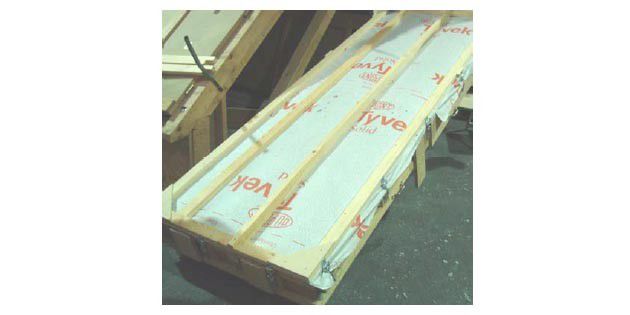Effective Cellulose Insulation
Article
Tyvek® and AirGuard® Membranes for Cellulose Insulation

Cellulose insulation is a lightweight material that first appeared in the 1980s, and is now firmly established in the insulation market. It is made of recycled wood fibre (mainly paper waste) to which fire retardants and wood preservation agents have been added. Advantages include good humidity absorbance and soundproofing capabilities, and the ability to reach and fill even difficult voids.
Cellulose thermal insulation is sold in flake form and is suitable for a wide range of applications. These include lofts with wooden and concrete joists, floors, exterior walls, pitched roofs, internal walls of dwellings and unfinished houses, and thermal rehabilitation of older houses.
Combining cellulose insulation with DuPont™ Tyvek® and AirGuard® membranes unites three high-performance products to give the optimum energy efficient insulation solution – one that is durable, airtight, water-resistant and able to fill awkward voids, as well as being soundproof.
Installation involves filling previously formed chambers with the material flakes. Chamber boundaries can be made of any rigid material (for example gypsum cardboard or OSB panels) – or of a flexible membrane such as a DuPont™ AirGuard® air and vapour control layer or Tyvek® breather membrane.
Proven Compatibility
Recent tests at the isofloc®* training facility in Lohfelden, Germany confirmed that DuPont™ AirGuard® and Tyvek® products are eminently suitable for use with cellulose insulation. In a series of rigorous tests, specialists from DuPont and isofloc® spent two days assessing the practicality of combining their respective products. The results confirm what many professional installers already know: DuPont™ AirGuard® and Tyvek® products work perfectly with cellulose insulation.
Installation Guidelines
Sealant: In pitched roof or wall applications, there is no need to seal Tyvek® underlay overlaps when creating an insulation space: an overlap of 15cm is sufficient to keep flakes or air inside the insulation space during blow-in. When installing flakes against an AirGuard® vapour control layer, however, overlap sealing is essential in order to achieve optimal airtightness.
Fixing the Membrane: Staples alone are not enough to fix AirGuard® or Tyvek® membranes in this application. Make sure counter battens are in place before blow-in.
Flying Counter Battens (Vertical Installation): When installing cellulose against a Tyvek® product, the pressure of the flakes can lift the membrane. This in turn could potentially invade the ventilation gap that is needed between Tyvek® and the tiles. To prevent this, tighten the membrane over the rafters, then install one flying counter batten for every 25cm of free space between the rafters. This will split the rafter field and diminish air gap loss. By installing flying counter battens with 2cm excess into the cellulose, you can increase the free space up to 35cm.
Supporting Battens (Horizontal Installation): When installing cellulose against an AirGuard® product, it is important to nail horizontal support battens against the vapour control layer (VCL) at distances of no more than 50cm. This will limit the outward bend of the membrane.
*isofloc® is a registered trademark of isofloc Wärmedämmtechnik GmbH.
